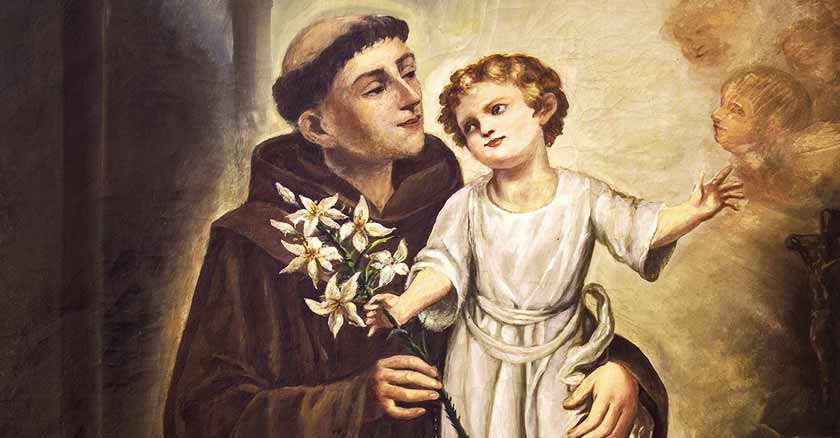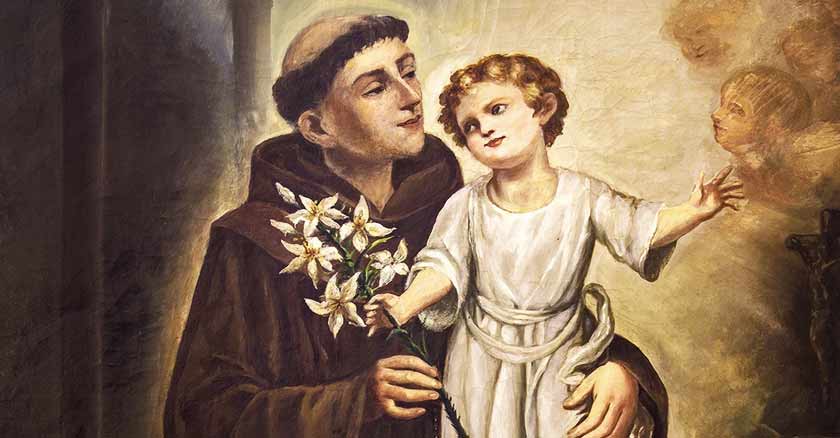Saint Anthony of Padua

(Lisbon, around 1195 - Arcella, near Padua, 1231) Franciscan saint of Portuguese origin, priest and doctor of the Church. His birth name was Fernando Martins; he was the first-born son of Martin de Alfonso, a Portuguese knight descended from French nobles (the Bouillons), and Maria Taveira.
He studied at the cathedral school, where an uncle of his was a teacher; Later, around 1210, he entered the monastery of canons regular of Saint Augustine of Saint Vincent de Fora, near Lisbon. There he had as teachers the prior himself, Pedro, and a man of extensive knowledge like Petrus Petri. But his family and friends did not accept his vocation and tried to force him to leave. To avoid these pressures he renounced his family inheritance and moved in 1212 to the monastery of Santa Cruz de Coimbra, an important center of religious education with a large library. In this other place he received the influence of the theological school of Saint Victor (Paris) through professors who had studied there. He also did not find peace in Coimbra, as the monastery was affected by the confrontation between King Alfonso II of Portugal and Pope Innocent III: his own prior, John, was excommunicated for supporting the Portuguese monarch.
Around 1219, when he was probably already a priest, he met the small Franciscan community of Coimbra, established shortly before in the hermitage of Olivais, and was attracted by its fraternal, evangelical and poor way of life. When shortly afterwards the remains of the first Franciscan martyrs, who died in Marrakech, arrived at his monastery, he decided to join the new order which, due to its recent creation, was not yet widespread and lacked the prestige that it would achieve later. Fra Juan Parenti, provincial of Spain, presided over the simple ceremony of taking the Franciscan habit (summer 1220), in which he changed his name from Ferdinand to Antonio (the Olivais hermitage was dedicated to Saint Anthony the Abbot), a symbol of his change. of life.
After a brief novitiate, and encouraged by the example of the Franciscan martyrs, it seems that in the autumn of that same year he embarked for Morocco together with another brother of the order, Brother Felipe de Castilla, to achieve martyrdom himself. However, shortly after disembarking he contracted malaria, a disease that would leave him with lifelong consequences; Convalescing throughout the winter, he was forced to leave the country. His intention was now to reach the Spanish coast and from there return by land to Portugal, but a storm took the ship in which he was traveling to Sicily. He stayed for some time in Milazzo (northeast coast of the island), where there was a Franciscan community, to complete his recovery.
In June 1221 he attended the chapter of his order in Assisi ("Chapter of the Mats", which gathered three thousand Franciscans); There he met Saint Francis of Assisi and decided not to return to Coimbra to enter the service of Brother Graciano, provincial of Romagna (a Franciscan circumscription that included all of northern Italy). Gratian sent him for a year to the hermitage of Montepaolo (near Forli) to strengthen himself before entrusting him with any apostolate mission.
In mid-1222, already enjoying good health, St. Anthony of Padua preached in the cathedral of Forli (without having previously prepared his words, but with great depth) on the occasion of some ordinations of Franciscans and Dominicans, and his provincial appointed him preacher and entrusted him to carry out his ministry throughout northern Italy. where Catharism was spreading in many places. In this way he traveled and taught in many places. His catechetical work in Rimini in 1223, for example, was difficult, but his public exhortations and discussions ended up being successful, converting, among others, Bononillo, a Cathar bishop. At the end of that year or the beginning of 1224 he was also in Bologna, teaching theology to other Franciscan friars in the convent of Santa Maria della Pugliola; He was the first teacher of the order, receiving permission to do so from Saint Francis, who wrote him a letter calling him "my bishop."
Around 1224 or 1225, his superiors transferred him to southern France, where the Albigensians were stronger than in Italy. His method of combating heresy consisted of leading an exemplary life, in conversations with non-believers and in catechism to strengthen the faith of Christians. He continued his theological teaching in Montpellier (where the Franciscans and Dominicans who were to preach in the region were trained) and Toulouse (a city with a strong Albigensian presence), in addition to being guardian of the convent of Le Puy-en-Velay. (west of Valence and Lyon) and, since the chapter of Arles in 1225, custodian of Limoges. As such, he established the residence of the city's Franciscans in a former Benedictine hermitage and founded a convent near Brieve.
At the end of 1225 he participated in the Synod of Bourges, which examined the situation in the region. Saint Anthony of Padua pointed out to the prelates the need to live simply to set an example; The bishop of Bourges, Simon de Sully, responded to his words and from then on applied the reform of customs, helping Franciscans and Dominicans for the evangelization of his diocese. The death of Saint Francis on October 3, 1226 forced him to travel to Assisi, as custodian of Limoges, to attend the general chapter that was to elect a new general minister; This took place on May 30, 1227 and Brother Juan Parenti was elected. Juan Parenti was elected. Aware of Antony's worth, he appointed him provincial of Romagna. Much loved by his friars, St. Antonio de Padua visited the places in his province where there were Franciscan convents; one of them was Vercelli, where he preached in the cathedral with great impact and met the theologian and canon regular Thomas Gallus.
He also had to spend long periods in Padua, where he founded a school for Franciscans and began writing a series of sermons. The fruit of his labors was the increase in preaching missions and the founding of numerous convents. At the general chapter of 1230, which met on the occasion of the transfer of the remains of Saint Francis to his basilica in Assisi, he asked Parenti to remove him from office due to his poor health. The general accepted his resignation in exchange for being part of a commission that had to present to Pope Gregory IX several questions about the Franciscan rule that the pontiff had to study and approve. Antony preached before him and before the Roman Curia and was listened to with enthusiasm: the Pope called him "Ark of the Testament."
It is possible that he collaborated in the writing of the bull Quo elongati, a response to the problems that the order posed to the pontiff. Then he headed to what would be his last destination, Padua, where he dedicated himself with such ardor that from then on his name would be associated with that of the city: Anthony of Padua. He first settled in the Arcella chapel, next to the Poor Clares convent, but he used to preach in the Franciscan convent of Santa María, outside the city walls. Street. Antonio of Padua wrote, at the request of Cardinal Rinaldo Conti (the future Alexander IV), a series of sermons according to the festivals of the liturgical year and preached to the point of exhaustion during Lent in 1231; His daily sermons were attended by a large part of the city and he obtained from the City Council the release of debtors imprisoned for not having the means to pay their debts (origin of the "Statute of San Antonio").
Shortly after, the podestà Esteban Badoer begged him to ask the powerful Ezzelino IV da Romano for the release of several Paduan nobles he had imprisoned; Thus, he traveled to Verona and met with Ezzelino, apparently without success, although a few months after Antonio's death he finally relented. In May, his health having worsened due to the trip, he retired to the nearby town of Camposampiero to rest and finish writing the Sermons. But the people, upon learning where he was, came in droves to hear him and ask for advice.
On Friday, June 13, he collapsed and, faced with the end approaching, asked to be transferred to Padua. This was done, although to avoid the crowds they stopped at Arcella, where Antonio died that same afternoon after receiving extreme unction and reciting the penitential psalms. He was not yet forty years old, and he had been carrying out his intense preaching for just over ten. Sacred speaker, founder of brotherhoods and brotherhoods, theologian and man of government, Saint Anthony of Padua left several treatises on mysticism and asceticism; all of his sermons were published.
A year after his death he was canonized and his cult, very popular, became widespread from the 15th century onwards. The most valuable representation of him is due to Goya, who represented him in the frescoes of the Hermitage of San Antonio de la Florida. He was proclaimed a doctor of the Church in 1946 by Pope Pius XII; His feast day is celebrated on June 13.

